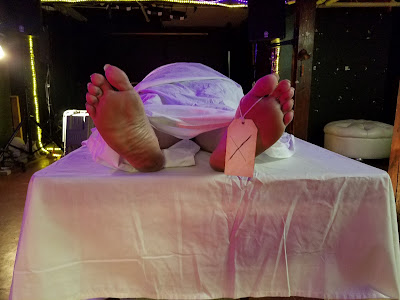Xavier Lopez Performance #5C: The Tryx Rabbit. Katherine Adamenko's Saons. 2001. While the last performance of the night was the return of the bear, the last one that we are covering is the Rabbit, also known as the Trix or Tryx Rabbit, which continues the adventures of the Soft Cyborg as the ultimate consumer/emcee creature. In this performance, donning the head of a stuffed bunny and wearing a tank top, I proceeded to mix plaster and the fruitloops from the earlier Krazy Cat performance in a failed attempt at making art--plaster will not set with regular milk! An important lesson in art!
As emcees, by selling their animated souls to
monopolies and mega-corporations they have become larger, longer lasting,
stronger, more powerful than the men that have created them. They no longer die, when their creators
die. They simply acquire a strange
voice, a new stance, shadowing and continue on.
They have become demi-hegemonic, that is, they continue as long as the
product they speak for continues to sell.
This sell/cel/cellular aspect of the soft-cyborg is fascinating and puts
our mortal bodies to shame.
Roger Rabbit, who made those first tentative steps into our world in the
thirties, only to find that he missed the comfort of his own world, we can find
a system that has begun to inverse itself.
One in which it is humans who are attempting to enter the world of these
cartoon characters, to trade in their flesh and blood for the promise of
immortality.
We Are Soft Cyborg
I have said before that our bodies have become soft,
infiltrated and injected with a creamy filling.
We have been asked to close our eyes as our systems have become more
plastic, more additive.
Pliant, suppliant
metal against flesh
We are Twinkies in that we are ingesting, and here I am
talking about a real scientific evolution—us becoming addicted at a cellular
level to the products of our desire.
The value of course is that it may be both our inevitable end
and our survival skill, if we imagine a world like the one in Max Headroom—a
program that was simply too honest to last long on television-we can imagine a
world that is owned part and parcel by large corporations-these corporations
are viruses, in that they seek to live for as long as they can using the
resources of their host body till the host is destroyed and empty. They are the viruses that we have created,
hard edged and machinelike they kill us with their cyborg bodies and hegemonic
minds.
If we
are to survive, we must become like Roger Rabbit, we must become like Road
Runner and Wile E. Coyote, our flesh must be pliant and perfect—we must become
the plastic and rubber that bounces back after being dropped from the top of
the Empire State Building. We must
discover the nirvana that occurs in those few moments when we are suspended in
mid-air before we drop. Our skin must
stretch like Plastic-man and allow the machine to pass through us
effortlessly. We must never bleed and
instead we must ooze. We must see
through the wild, white lidless eyes that see all, but know the rules of the
mystery. If not, the Terminator will
necessarily destroy us. In essence we
must evolve, grow and become what we were always meant to be. Soft.
That is the message of the Soft Cyborg.




































